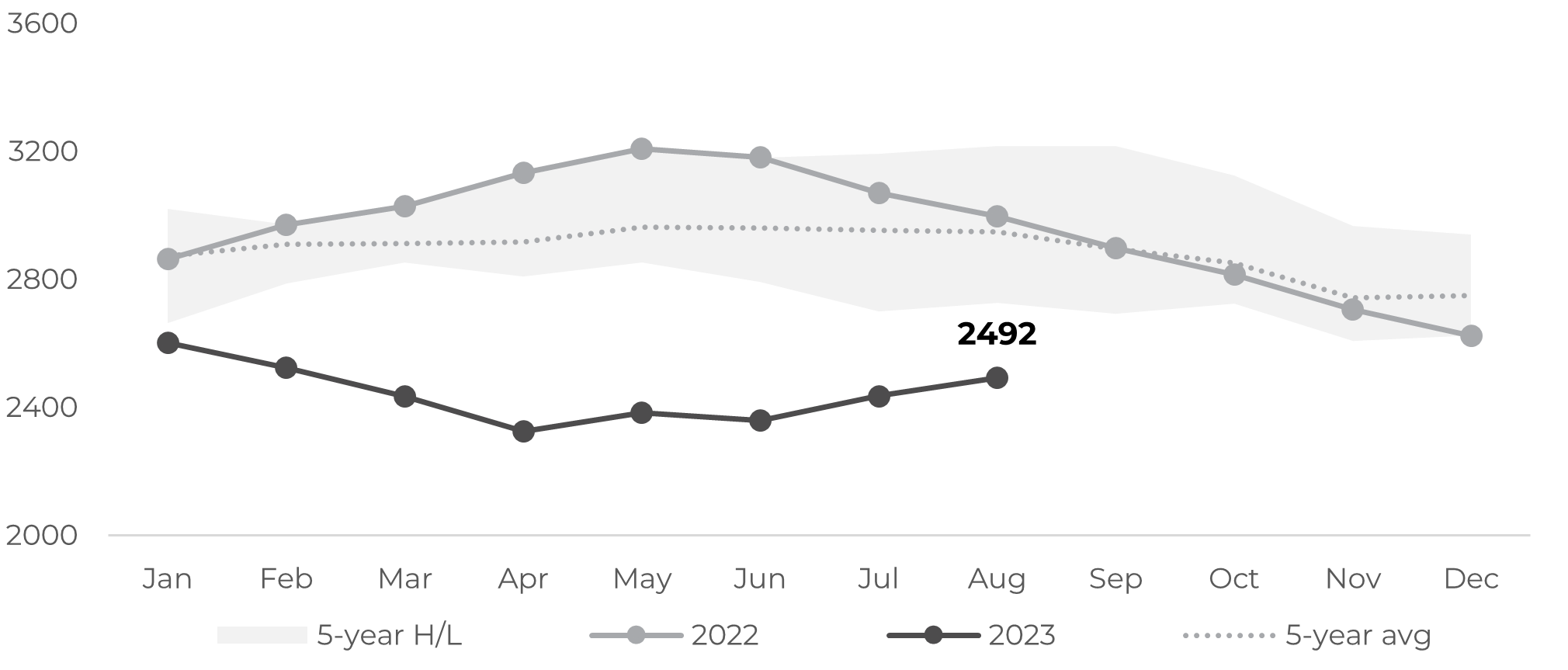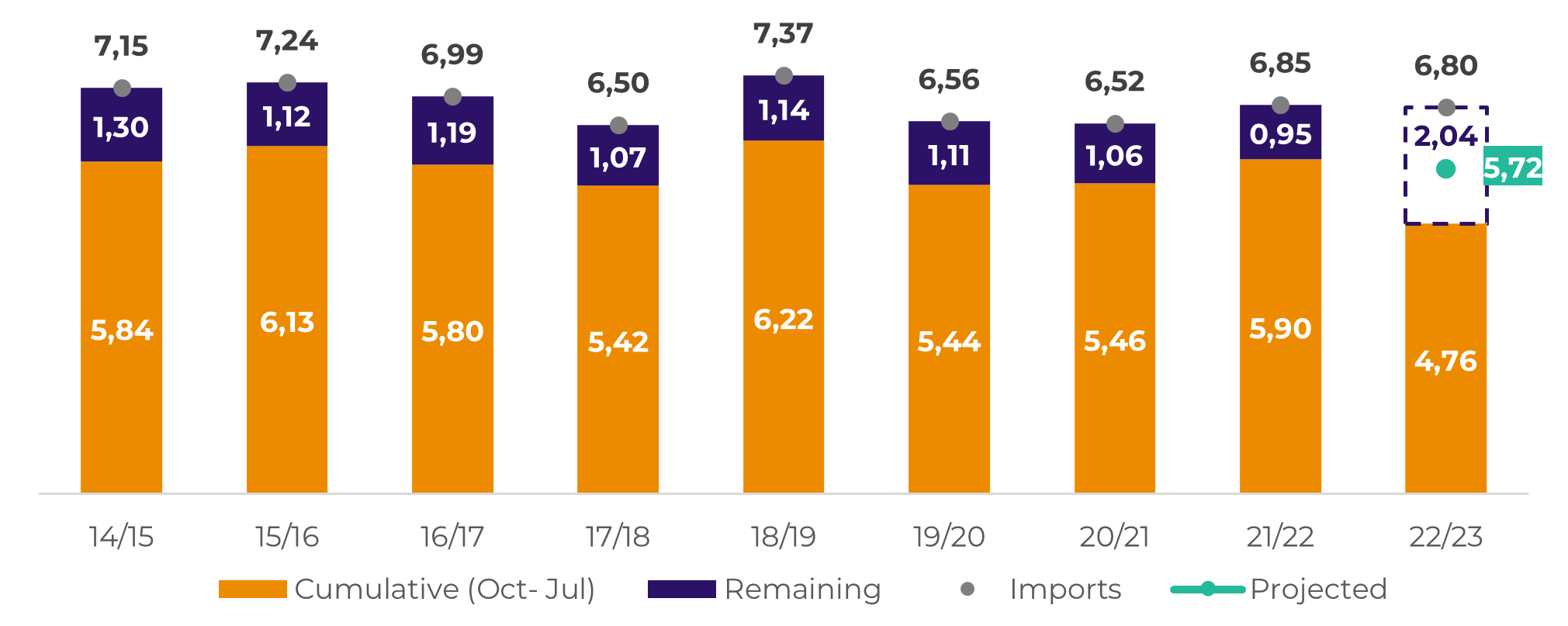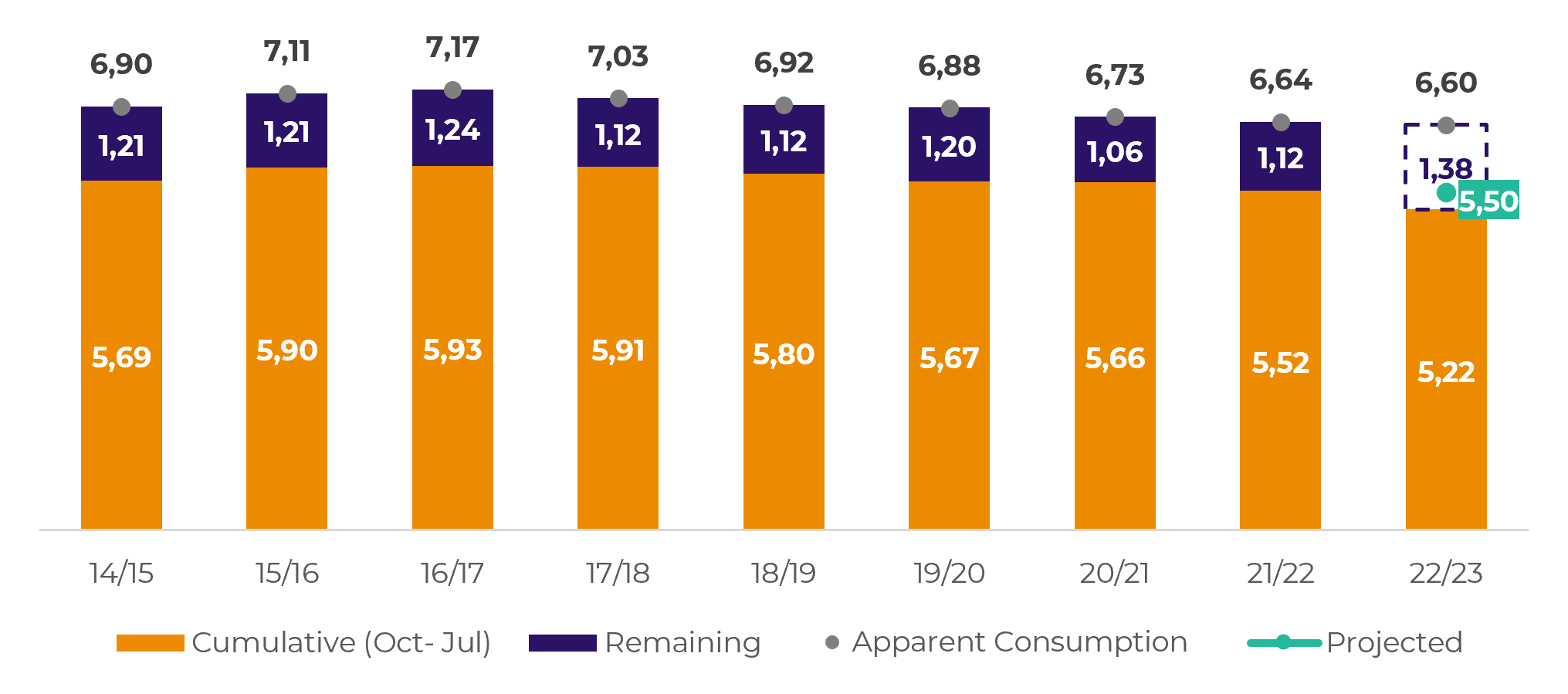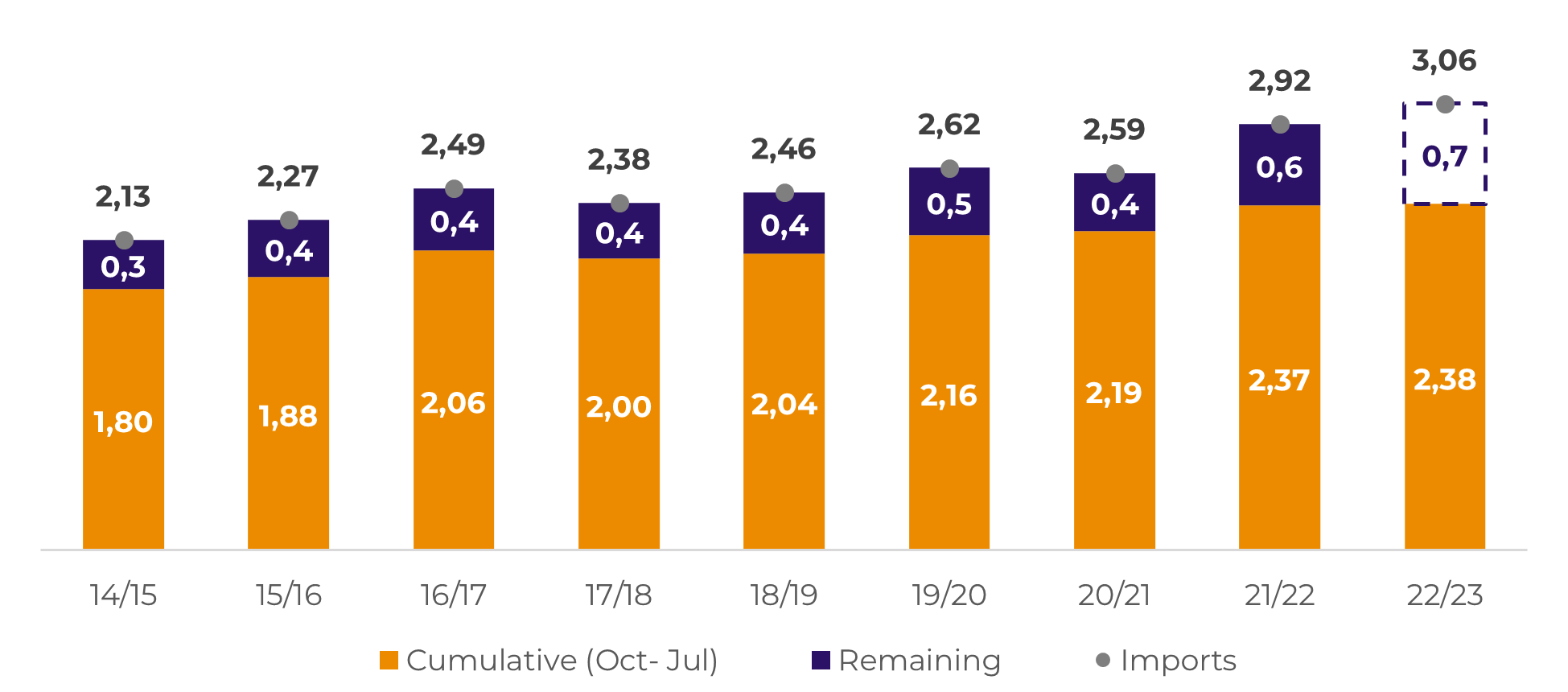
Oct 6
Coffee Weekly Report - 2023 10 06
Back to main blog page
- Japan's coffee stocks rebounded to 2.5M bags in August, up 2.3% MoM but still below roasters' typical levels, averaging 19-20 weeks compared to the usual 23-24 weeks.
- Despite a 23% YoY decline in imports from October to June, the gap narrowed, with the July figure down 19% compared to the same window in the 21/22 cycle.
- South Korea experienced increased imports (2.38M bags) surpassing last year's figures. The profile of coffee imports shifted, with a notable recovery in the share of arabica origins, reaching 43% in July.
- The discrepancy in imports and rising stocks in Japan suggests a slight bearish tone, with apparent consumption around 5% below expected levels. South Korea, however, shows a more positive trend with growing imports and a changing coffee origin profile.
Asian Coffee Markets: Trends and Contrasts
This week, we saw the release of coffee inventory figures for Japan, and in this report, we will take a look at indicators from two main Asian coffee destinations, Japan and South Korea.
In the last report about the Asian market, we highlighted that stocks were slowly rebuilding after a significant drawdown driven by lower imports. The trend has continued into August, reaching 2.5M bags (+2.3% month-over-month, vs. the +0.3% expected for August, Chart #1) - but still well below the usual roasters' stock levels expected for the country (on average, for the period, Japan works with 23-24 weeks worth of stocks, and the current metric is at 19-20 weeks).
Looking at imports to derive the apparent consumption marker, the difference in the cumulative figures when compared to the last cycle has shortened: from October to June, imports were 23% lower year-over-year, and 19% below the estimates for the period.
For the October-July period, imports are 19% below 21/22 (4.76M bags vs. 5.90M), and 16% below the estimated figures for the period (5.72M bags, Chart #2).
Image 1: Coffee Stocks – Japan (‘000 bags)

Source: Japan Coffee Association
Image 2: Coffee Imports – Japan (M bags)

Source: Japan Coffee Association
Still, despite a closer metric in terms of imports in July when compared to June, it doesn't explain by itself the stock increase, and apparent consumption remains roughly 5% below what would be expected for the period (5.22M bags vs. 5.50M bags) and also 5.4% below the same window in the 21/22 cycle (Chart #3). Therefore, despite an improvement in inputs, the output remains with a slight bearish tone.
Now, it's important to make a distinction: imports are not behaving exactly the same across Asian countries. In South Korea, imports from October to July are at 2.38M bags, above the same period last year, and in line to meet the just over 3M bags expected for the current cycle.
Also, the profile of coffee imported by the country has changed when compared to the beginning of the year. In the first quarter, South Korea imported on average 36% of its volume from primarily arabica origins. The metric was mostly unchanged for the second quarter, at 37%. Still, into the third quarter, the first figure already shows a substantial recovery: 43% in July - the historical average stands at roughly 40%, and has decreased over time (50% in 2008, vs. 25% in 2022).
Image 3: Apparent Coffee Consumption – Japan (M bags)

Source: hEDGEpoint
Image 4: Coffee Imports – South Korea (M bags)

Source: Trade Map
In Summary
This week's focus is on coffee inventory in key Asian destinations, Japan and South Korea. Japan's stocks rebounded to 2.5M bags in August, up 2.3% MoM but still below the typical roasters' stock levels. Despite a 23% YoY decline in imports from October to June, the gap narrowed, with the July figure down 19% compared to the same window in the 21/22 cycle.
South Korea, in contrast, saw increased imports (2.38M bags) surpassing last year. Interestingly, the profile of coffee imports shifted, with a notable recovery in the share of arabica origins, reaching 43% in July compared to the historical average of around 40%. For the upcoming cycle, the trend is expected to be seen in other destinations as well, highlighting arabica on the global stage.
Weekly Report — Coffee
Written by Natália Gandolphi
natalia.gandolphi@hedgepointglobal.com
natalia.gandolphi@hedgepointglobal.com
Reviewed by Pedro Schicchi
pedro.schicchi@hedgepointglobal.com
www.hedgepointglobal.com
Disclaimer
This document has been prepared by hEDGEpoint Global Markets LLC and its affiliates ("HPGM") exclusively for informational and instructional purposes, without the purpose of creating obligations or commitments with third parties, and is not intended to promote an offer, or solicitation of an offer, to sell or buy any securities or investment products. HPGM and its associates expressly disclaim any use of the information contained herein that may result in direct or indirect damage of any kind. If you have any questions that are not resolved in the first instance of contact with the client (client.services@hedgepointglobal.com), please contact our internal ombudsman channel (ouvidoria@hedgepointglobal.com) or 0800-878-8408 (for clients in Brazil only).
Contact us
hedgepointhub.support@hedgepointglobal.com
ouvidoria@hedgepointglobal.com
Funchal Street, 418, 18º floor - Vila Olímpia São Paulo, SP, Brasil
Check our general terms and important notices.
This page has been prepared by Hedgepoint Schweiz AG and its affiliates (“Hedgepoint”) solely for informational and instructional purposes, without the purpose of instituting obligations or commitments to third parties, nor is it intended to promote an offer, or solicitation of an offer of sale or purchase relating to any securities, commodities interests or investment products. Hedgepoint and its associates expressly disclaim any use of the information contained herein that directly or indirectly result in damages or damages of any kind. Information is obtained from sources which we believe to be reliable, but we do not warrant or guarantee the timeliness or accuracy of this information. The trading of commodities interests such as futures, options, and swaps involves substantial risk of loss and may not be suitable for all investors. You should carefully consider wither such trading is suitable for you in light of your financial condition. Past performance is not necessarily indicative of future results. Customers should rely on their own independent judgement and/or advisors before entering in any transaction.Hedgepoint does not provide legal, tax or accounting advice and you are responsible for seeking any such advice separately.Hedgepoint Schweiz AG is organized, incorporated, and existing under the laws of Switzerland, is filiated to ARIF, the Association Romande des Intermédiaires Financiers, which is a FINMA-authorized Self-Regulatory Organization. Hedgepoint Commodities LLC is organized, incorporated, and existing under the laws of the USA, and is authorized and regulated by the Commodity Futures Trading Commission (CFTC) and a member of the National Futures Association (NFA) to act as an Introducing Broker and Commodity Trading Advisor. HedgePoint Global Markets Limited is Regulated by the Dubai Financial Services Authority. The content is directed at Professional Clients and not Retail Clients. Hedgepoint Global Markets PTE. Ltd is organized, incorporated, and existing under the laws of Singapore, exempted from obtaining a financial services license as per the Second Schedule of the Securities and Futures (Licensing and Conduct of Business) Act, by the Monetary Authority of Singapore (MAS). Hedgepoint Global Markets DTVM Ltda. is authorized and regulated in Brazil by the Central Bank of Brazil (BCB) and the Brazilian Securities Commission (CVM). Hedgepoint Serviços Ltda. is organized, incorporated, and existing under the laws of Brazil. Hedgepoint Global Markets S.A. is organized, incorporated, and existing under the laws of Uruguay. In case of questions not resolved by the first instance of customer contact (client.services@Hedgepointglobal.com), please contact internal ombudsman channel (ombudsman@hedgepointglobal.com – global or ouvidoria@hedgepointglobal.com – Brazil only) or call 0800-8788408 (Brazil only).Integrity, ethics, and transparency are values that guide our culture. To further strengthen our practices, Hedgepoint has a whistleblower channel for employees and third-parties by e-mail ethicline@hedgepointglobal.com or forms Ethic Line – Hedgepoint Global Markets.Security note: All contacts with customers and partners are conducted exclusively through our domain @hedgepointglobal.com. Do not accept any information, bills, statements or requests from different domains and pay special attention to any variations in letters or spelling, as they may indicate a fraudulent situation.“HedgePoint” and the “HedgePoint” logo are marks for the exclusive use of HedgePoint and/or its affiliates. Use or reproduction is prohibited, unless expressly authorized by HedgePoint. Furthermore, the use of any other marks in this document has been authorized for identification purposes only. It does not, therefore, imply any rights of HedgePoint in these marks or imply endorsement, association or seal by the owners of these marks with HedgePoint or its affiliates.
We have updated our Terms & Conditions to reflect improvements to our platform, data handling practices, and the overall experience we provide to our clients.
To continue using the Hedgepoint HUB, please review and accept the updated terms.

